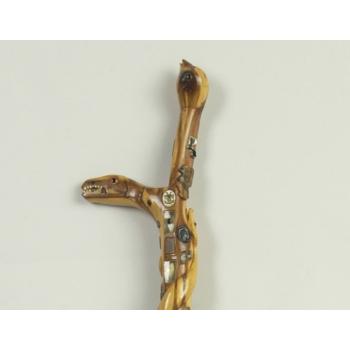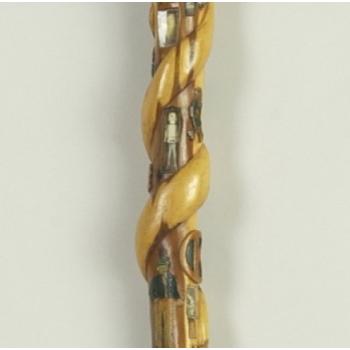Bert M. Ohnstad (Friendship Cane)
Bert Ohnstad, born in 1892 in Dane County, Wisconsin, was a Boy Scout executive in Altus, Oklahoma in 1928 when the Friendship Cane was begun. He had 87 scouts in camp at Craterville in the Wichita Mountains. Each night at the campfire, there was a speaker and they would sing, debate, and discuss safety measures and usually finished up the evening with a game called "Challenges." At this particular camp fire, several scouts challenged other scouts and they settled on climbing Mt. Scott, the highest mountain in the Wichitas.
Bert Ohnstad selected a branch to use as a walking stick on this particular expedition—he selected a cedar limb with a small branch that had the possibility of being shaped into a bird’s head. The Friendship Cane was cut June 18, 1929, a souvenir of Mt. Scott at Lawton, Oklahoma. The wood is Juniperus Virginiana.
Another scoutmaster, J.T. Bailey, gave Bert a small gold heart on which the Lord’s Prayer was carved. He asked Bert to add it to the cane as a remembrance of him—the memento had been given to Mr. Bailey by his mother as he left for France in the First World War. Mr. Bailey’s suggestion led to making the cane a "Friendship Cane". Over the course of the next 50 years, more than 120 small artifacts and mementos were added to the cane. Among the imbedded artifacts are a shield given by a German General to Kaiser Wilhelm, a piece of stone from the Taj Mahal, a one dollar gold coin from 1851, a face made of a hickory nut, Uncle Sam carved in relief and painted, a piece of hippopotamus hide from South Africa, and others.
This exceptional memory piece came to Kohler Foundation through Bert’s niece, Elizabeth Robinson and her husband Robert. The cane is part of the permanent collection of the John Michael Kohler Arts Center in Sheboygan, WI.





